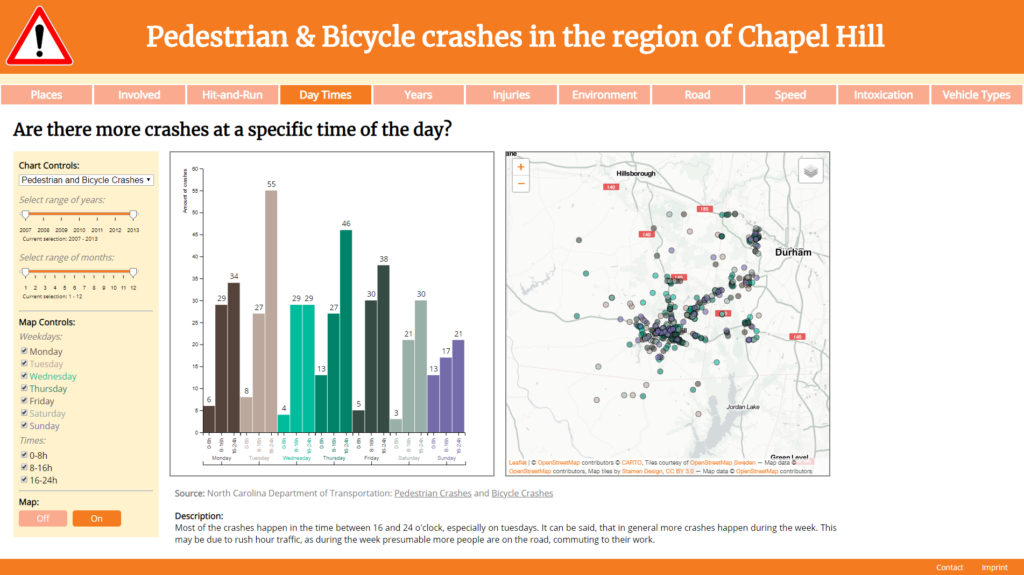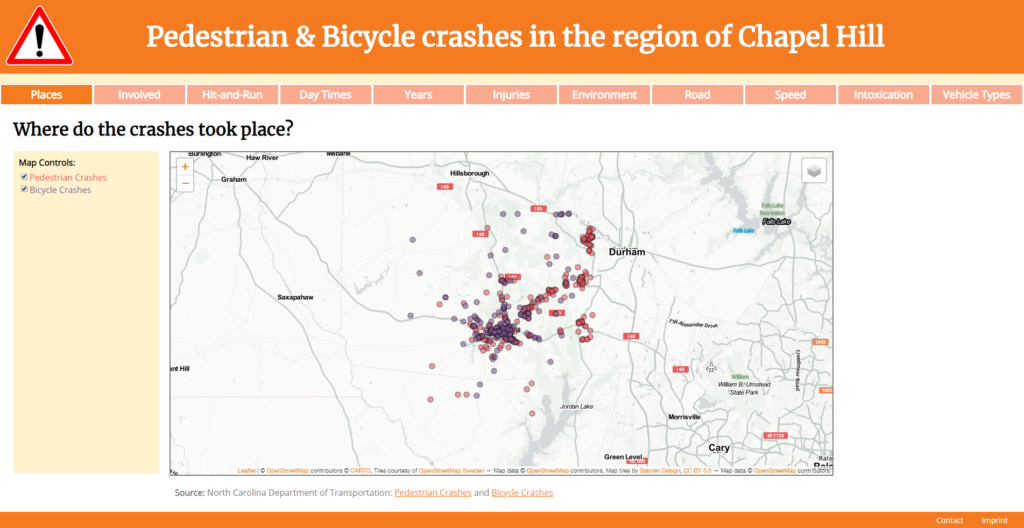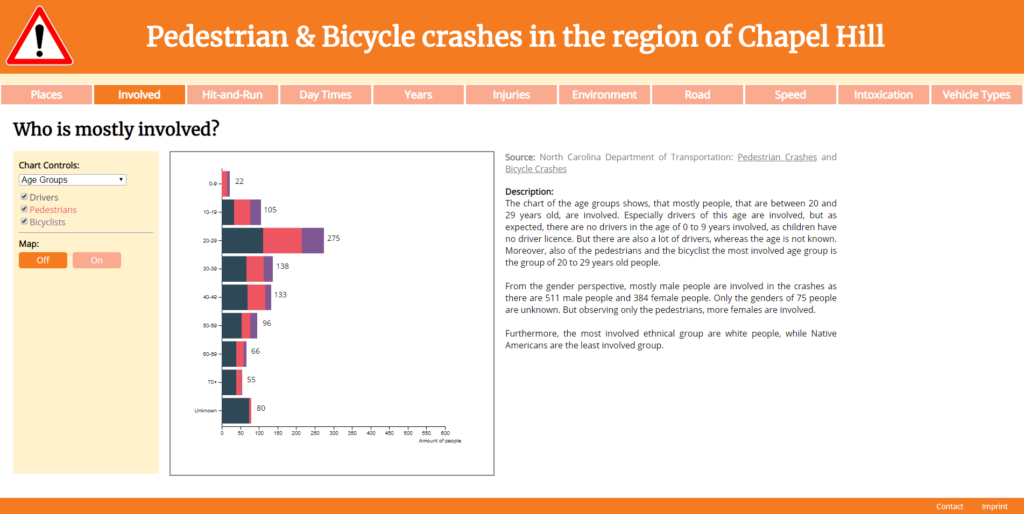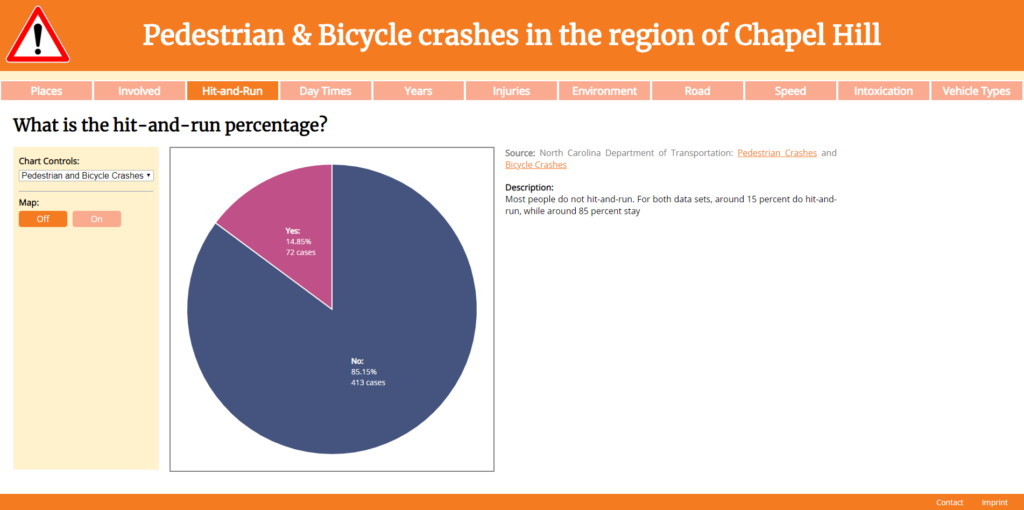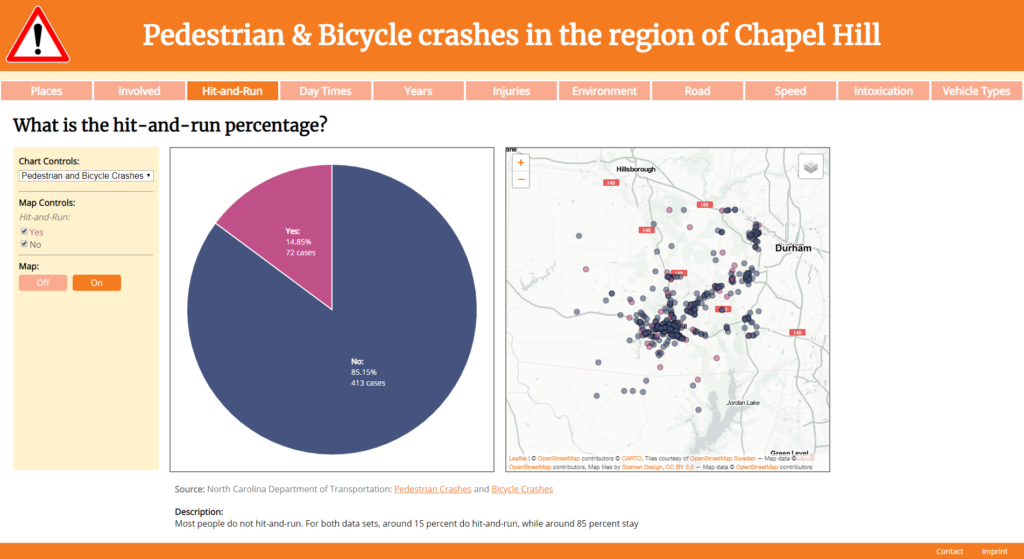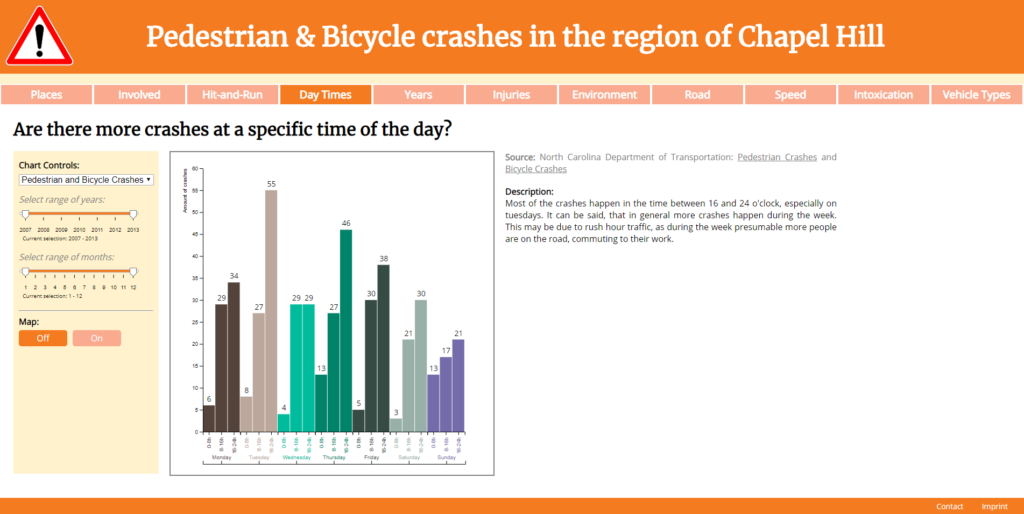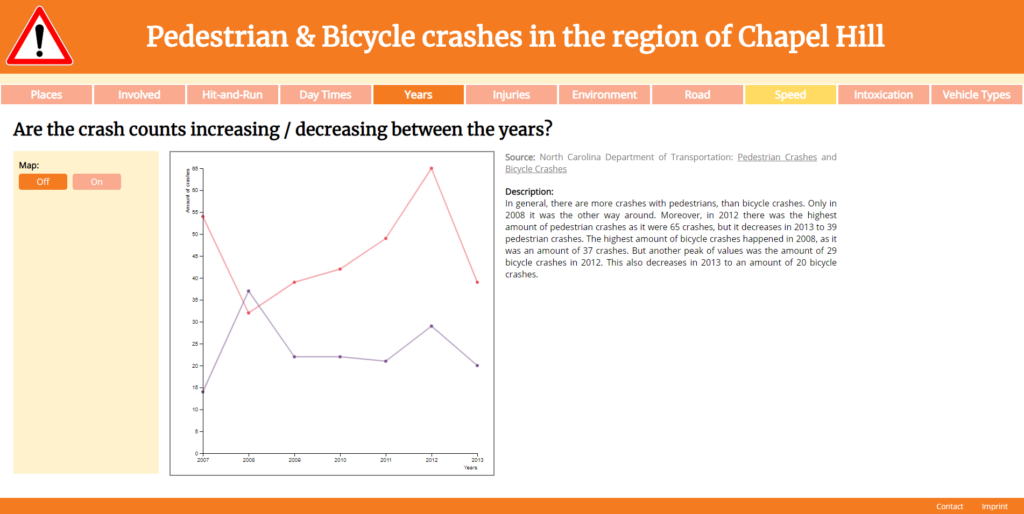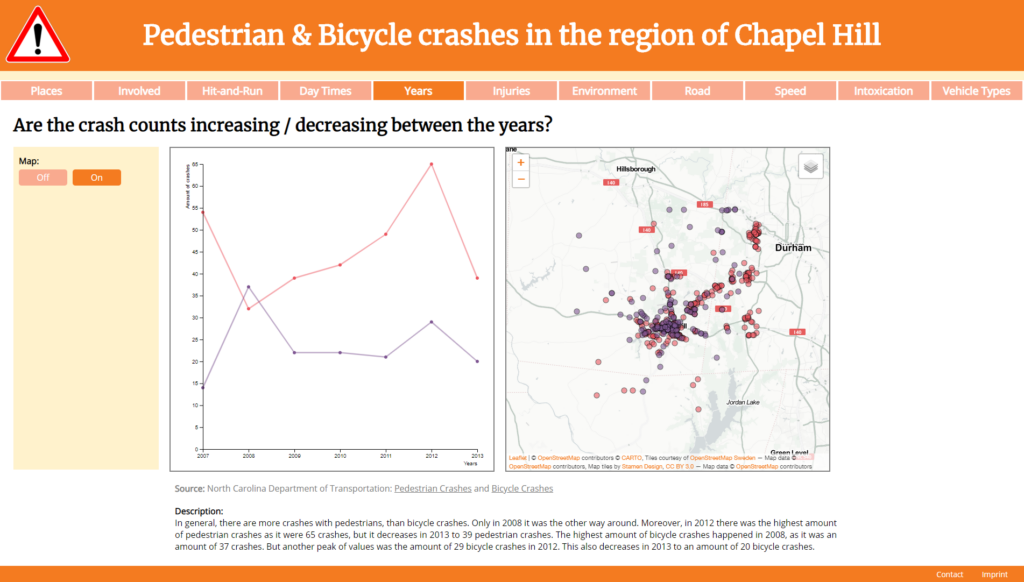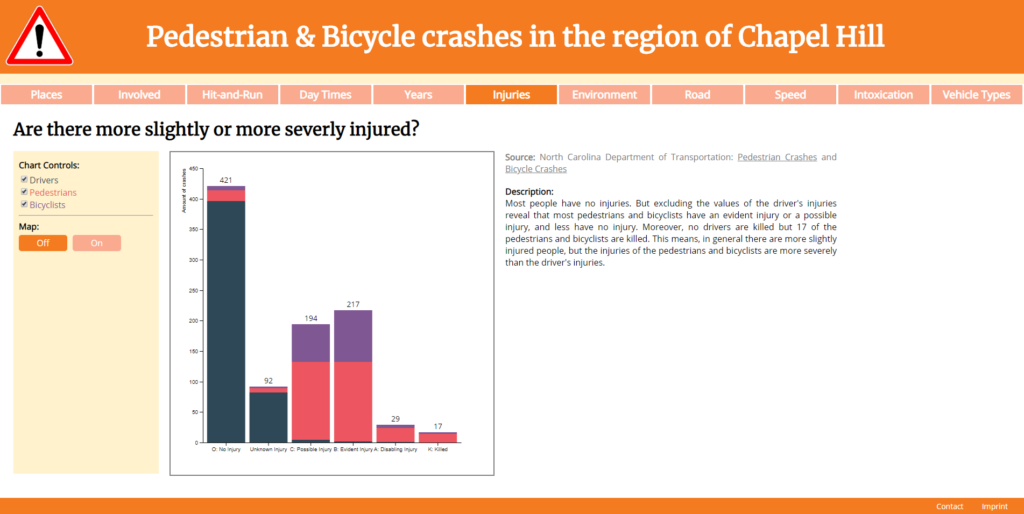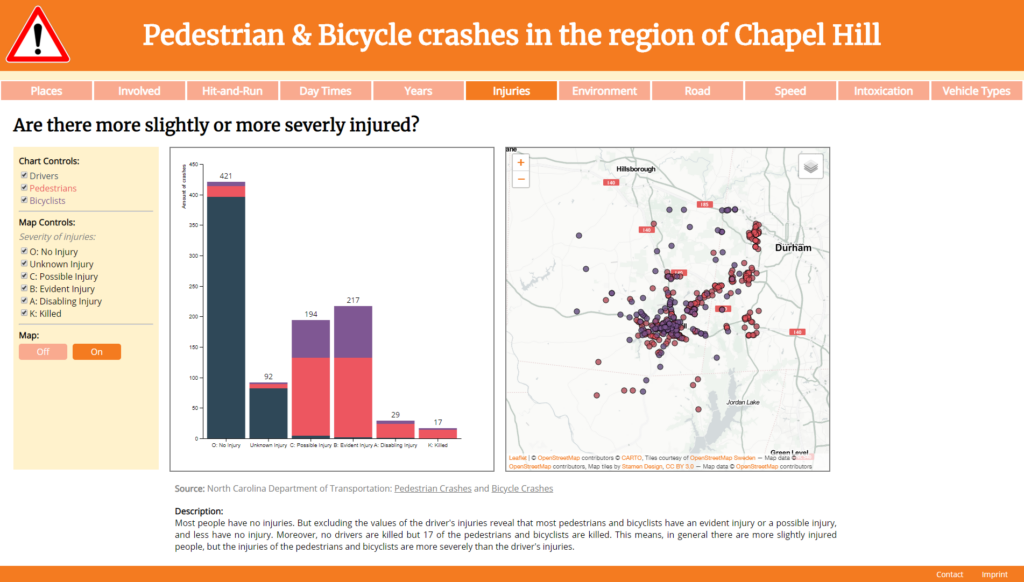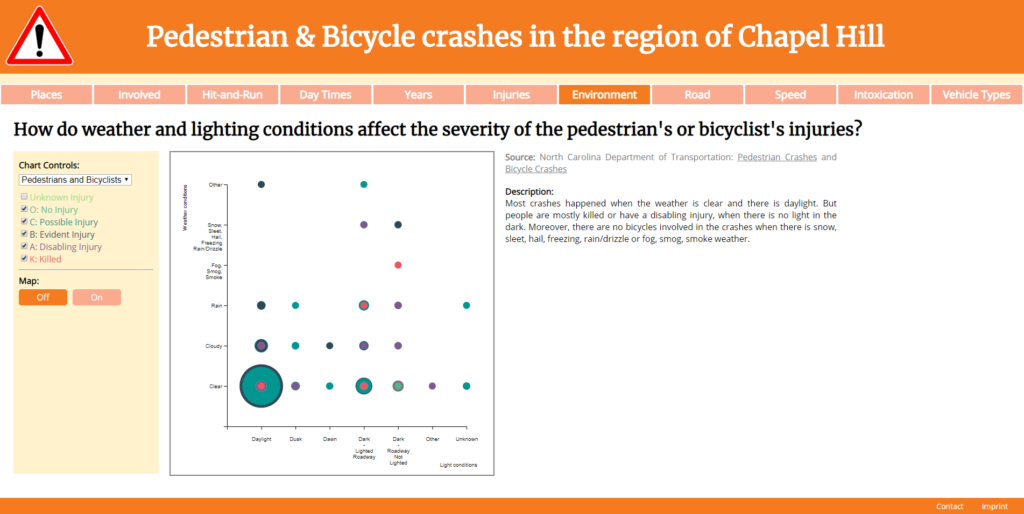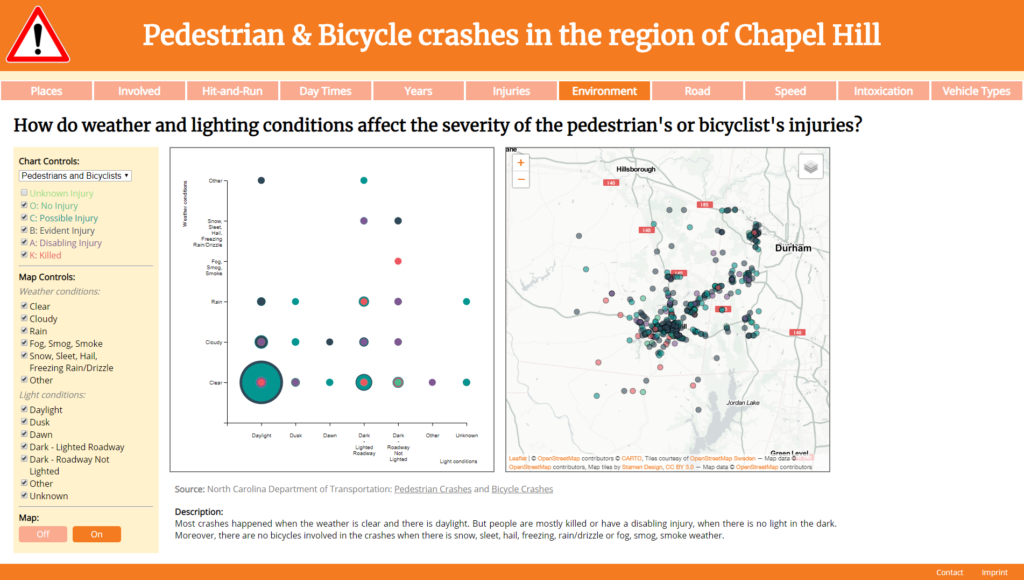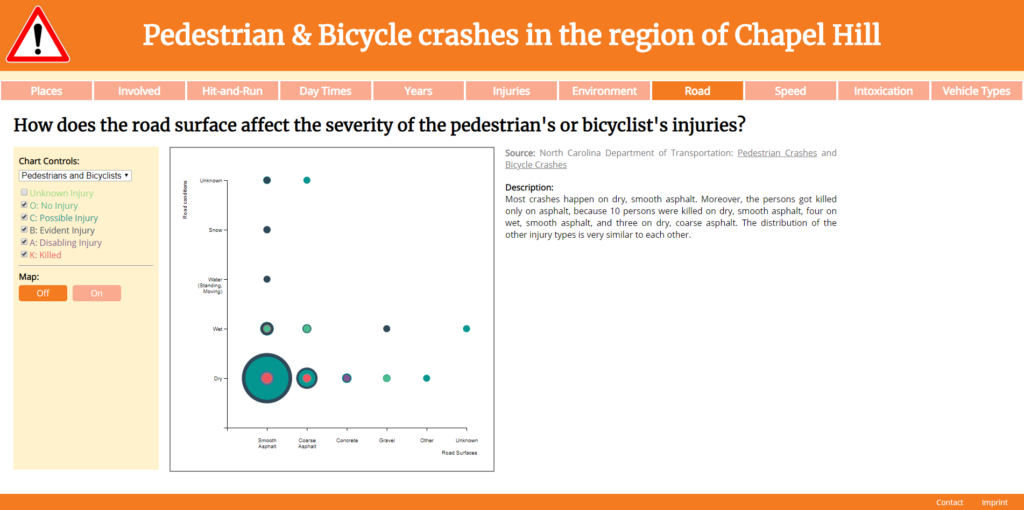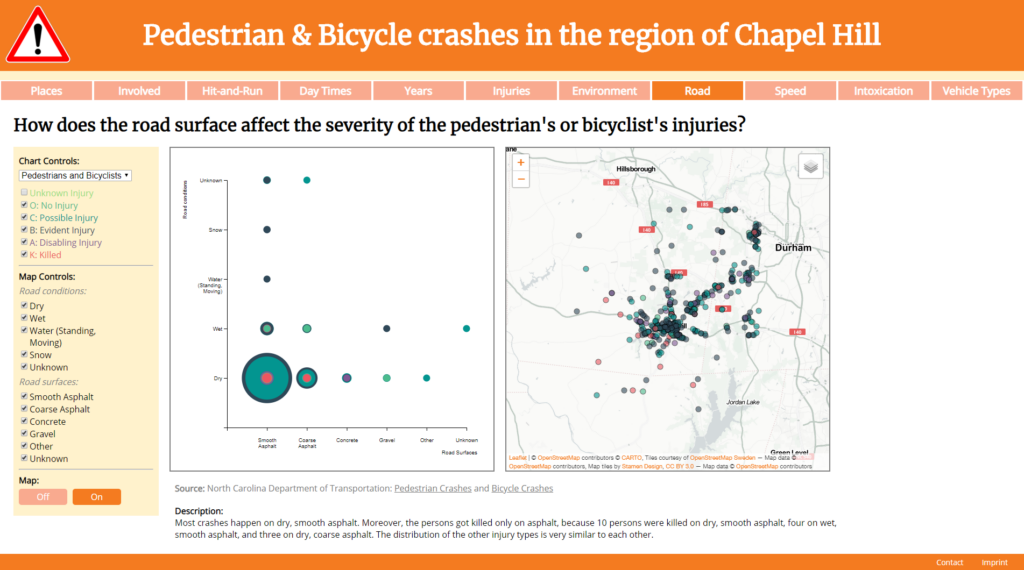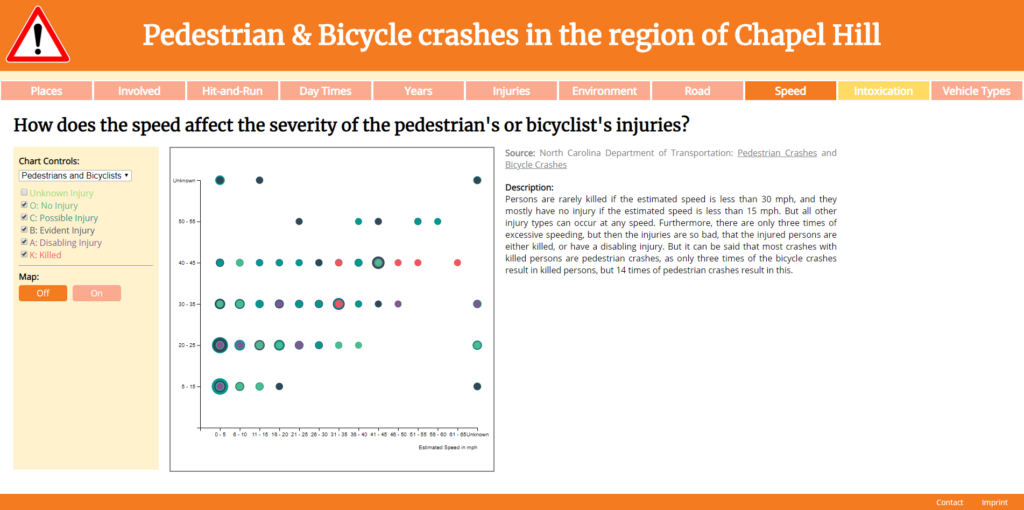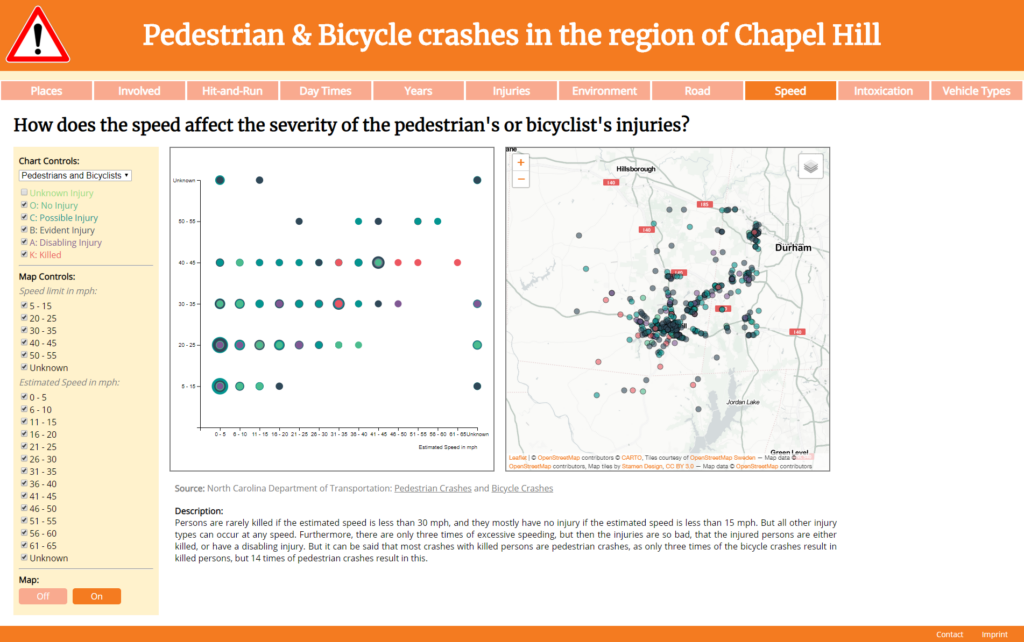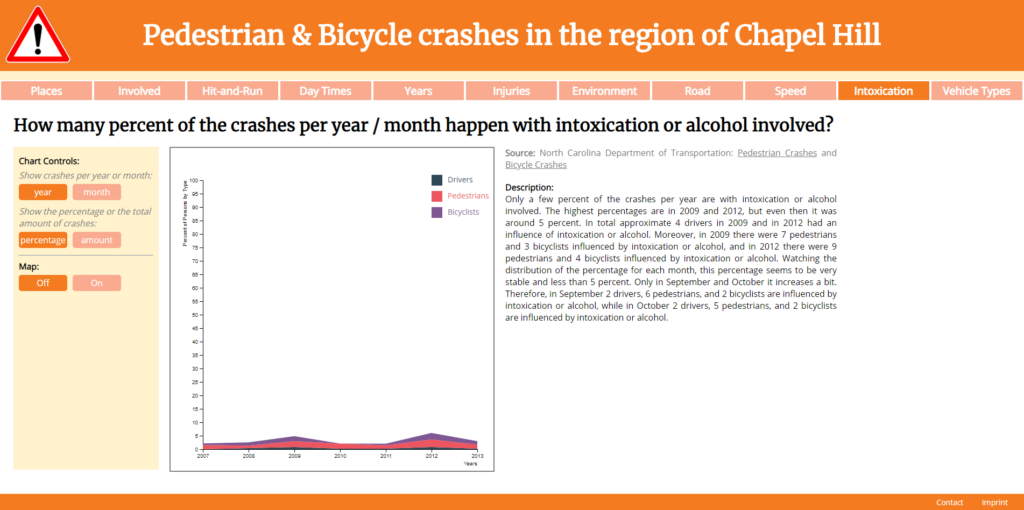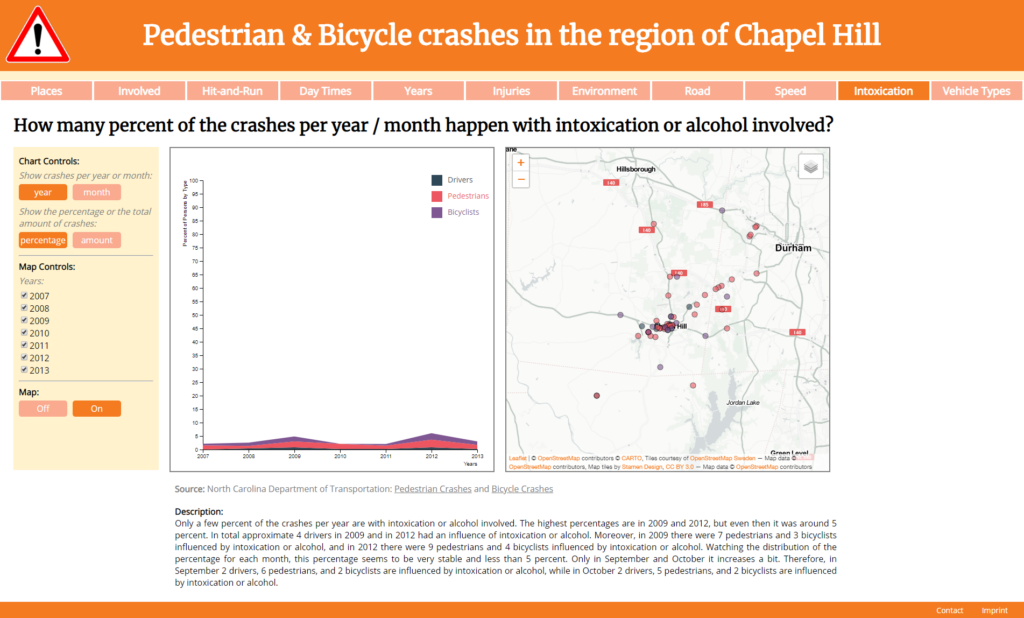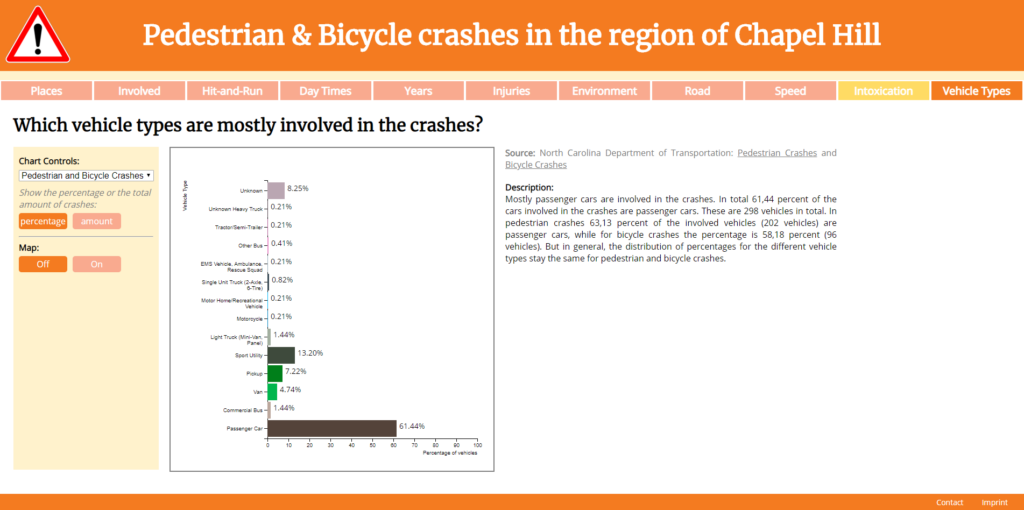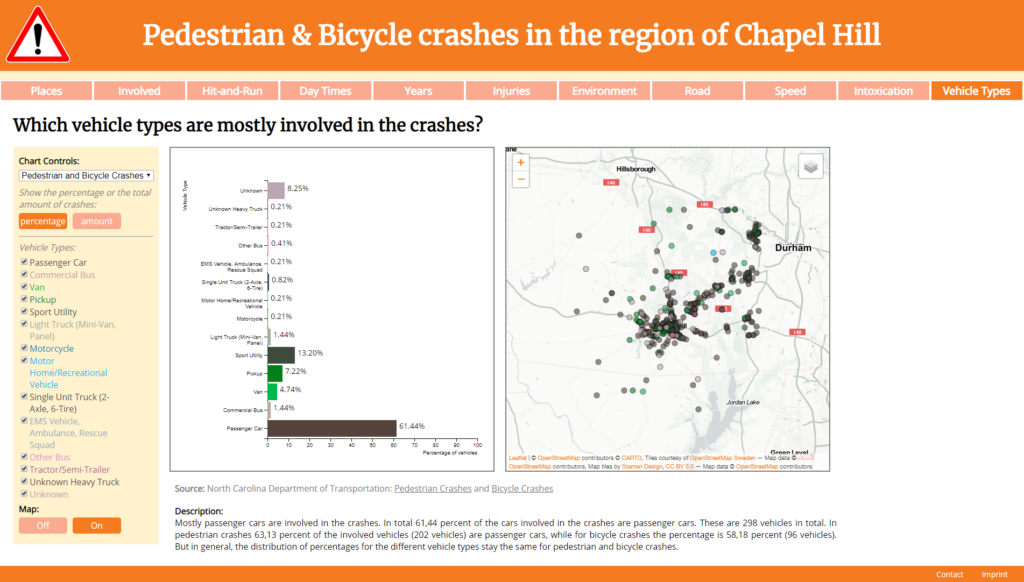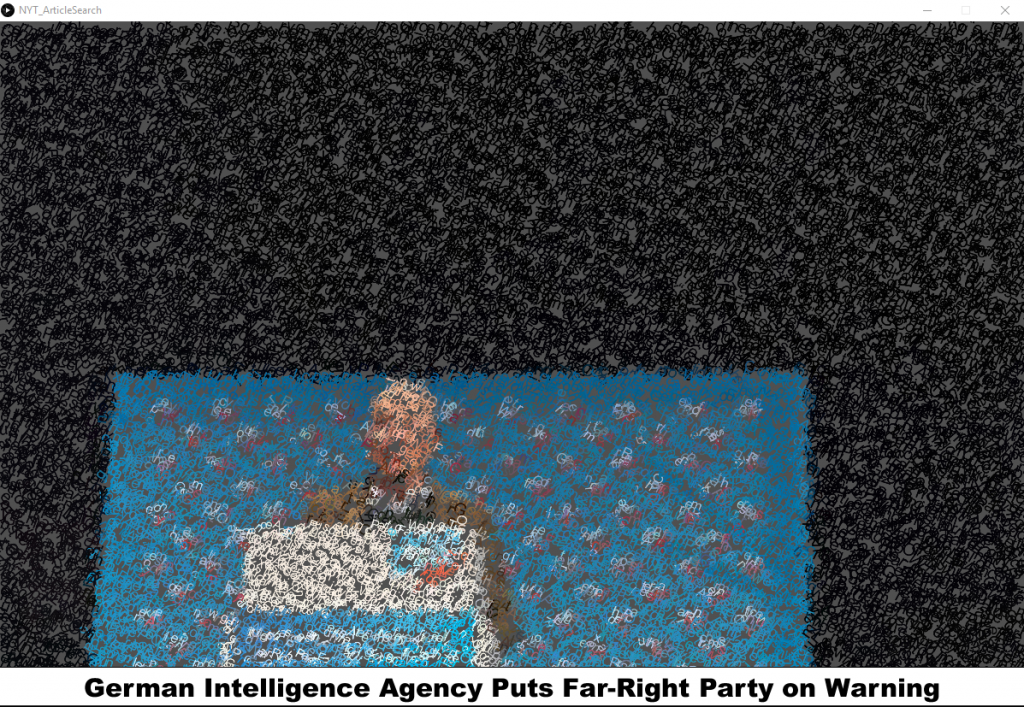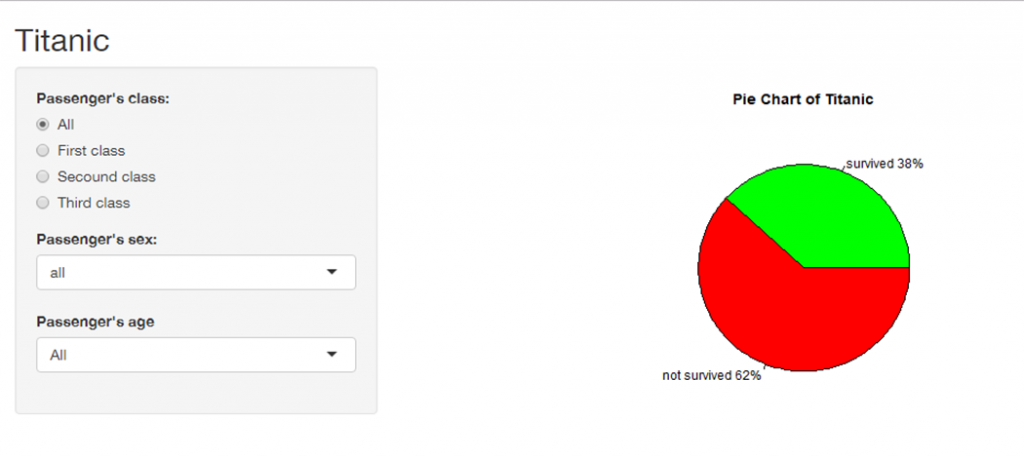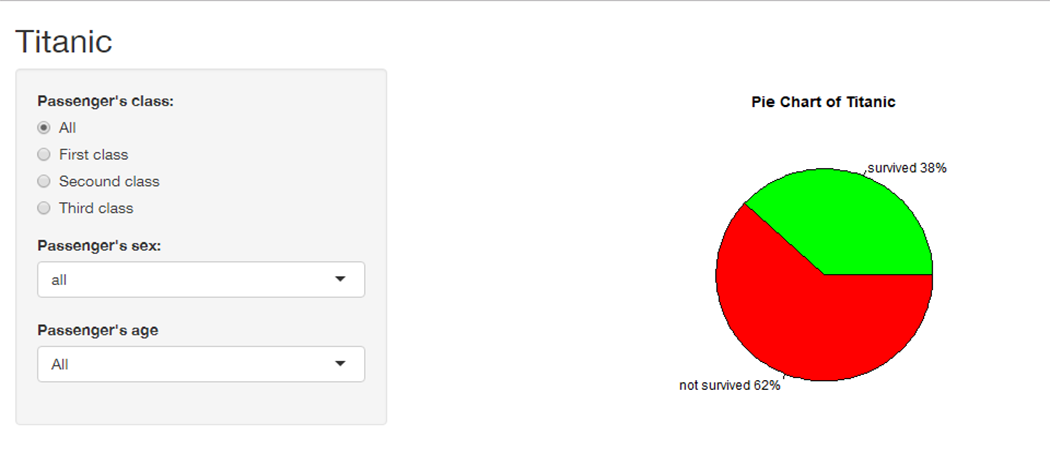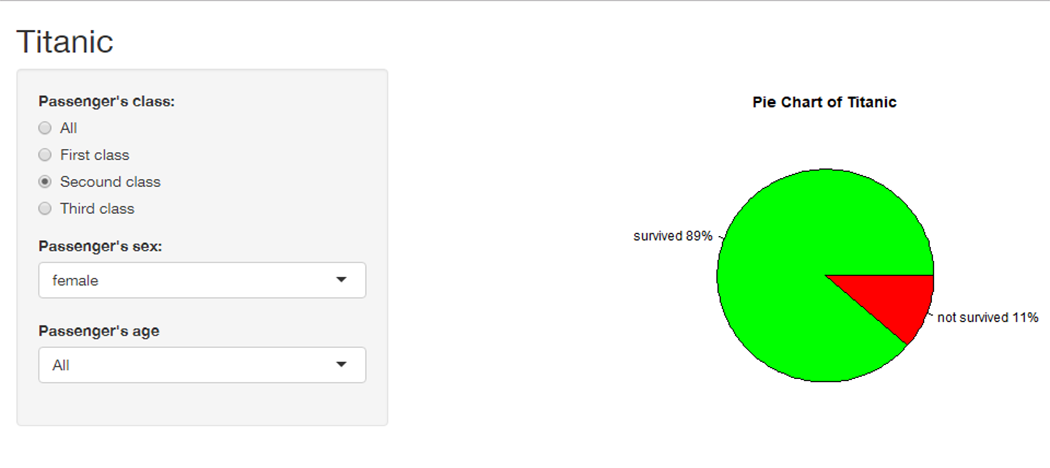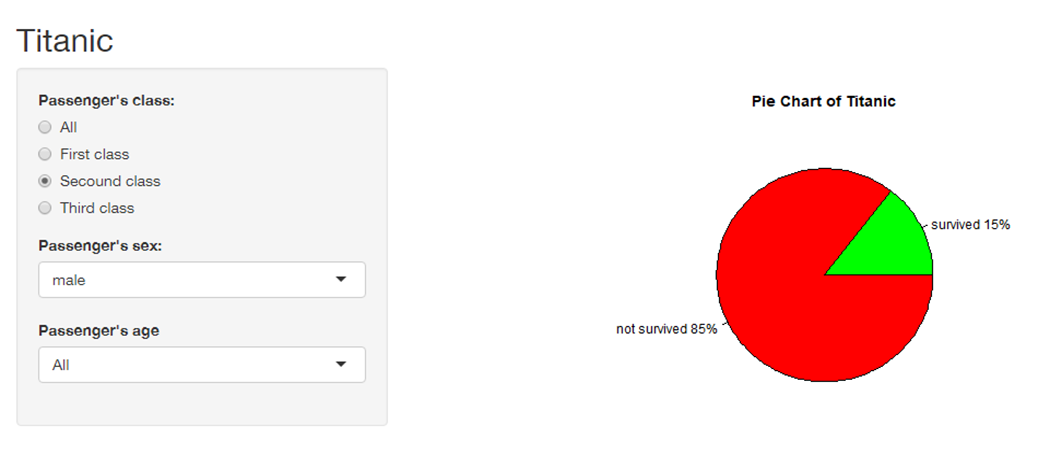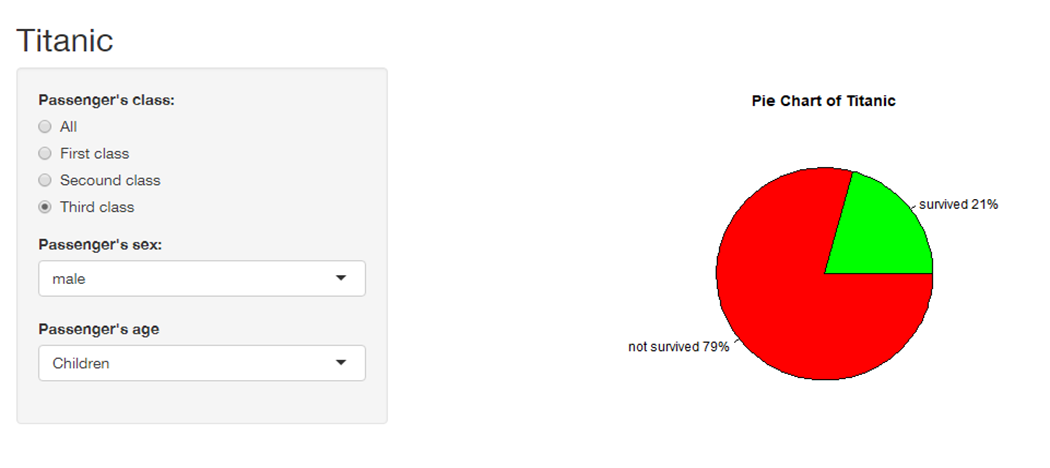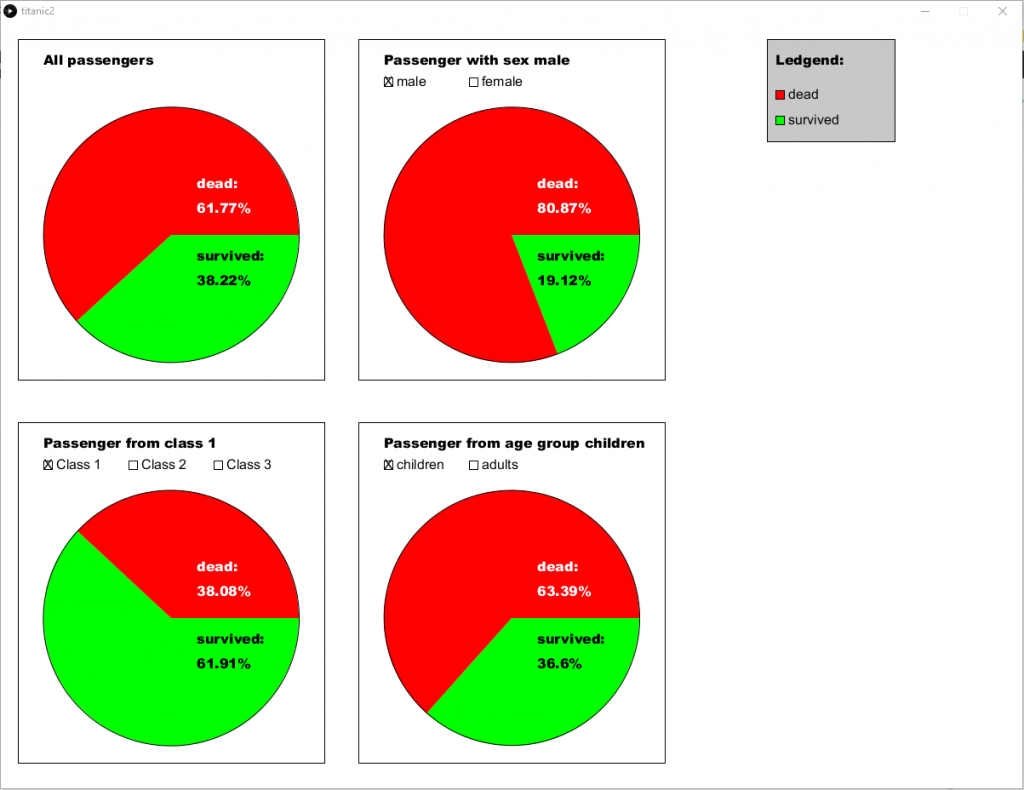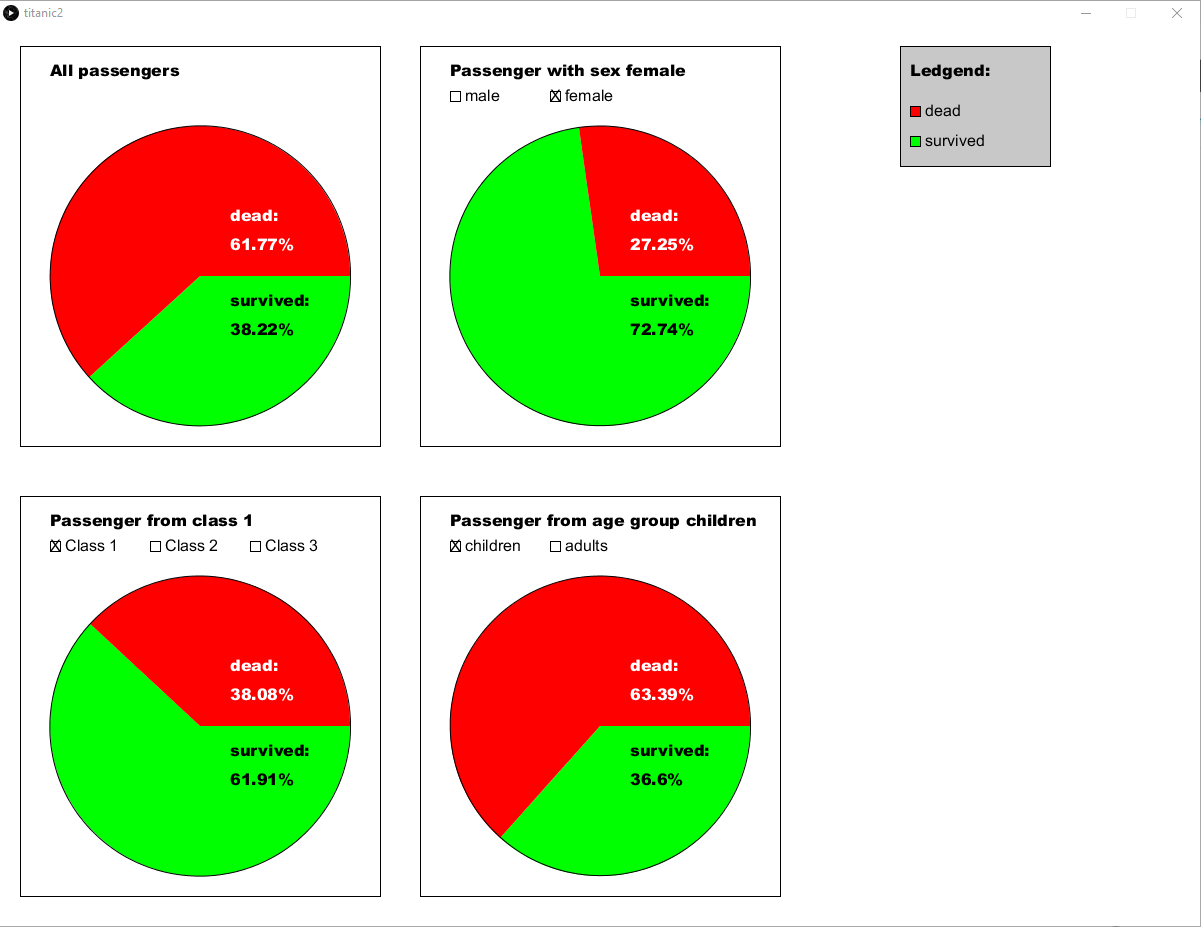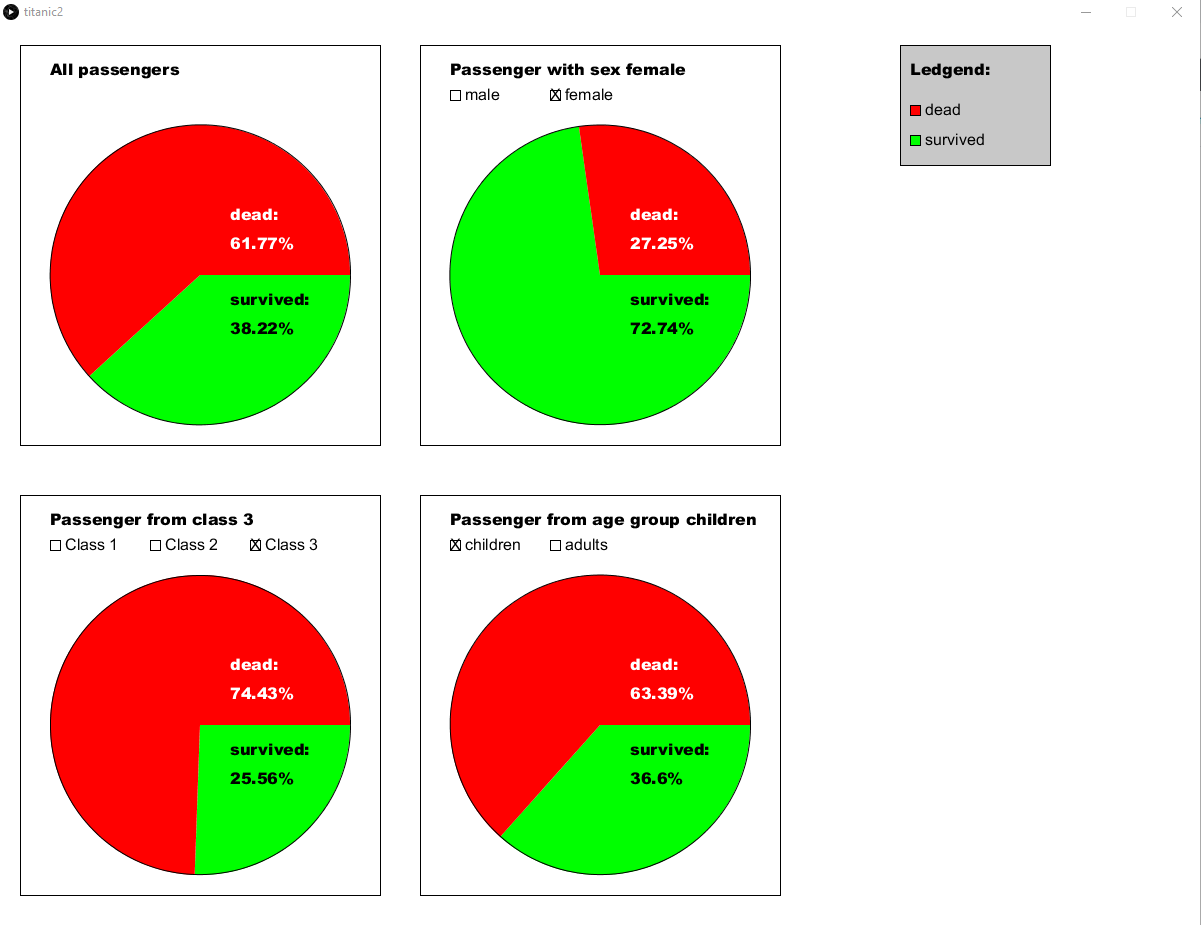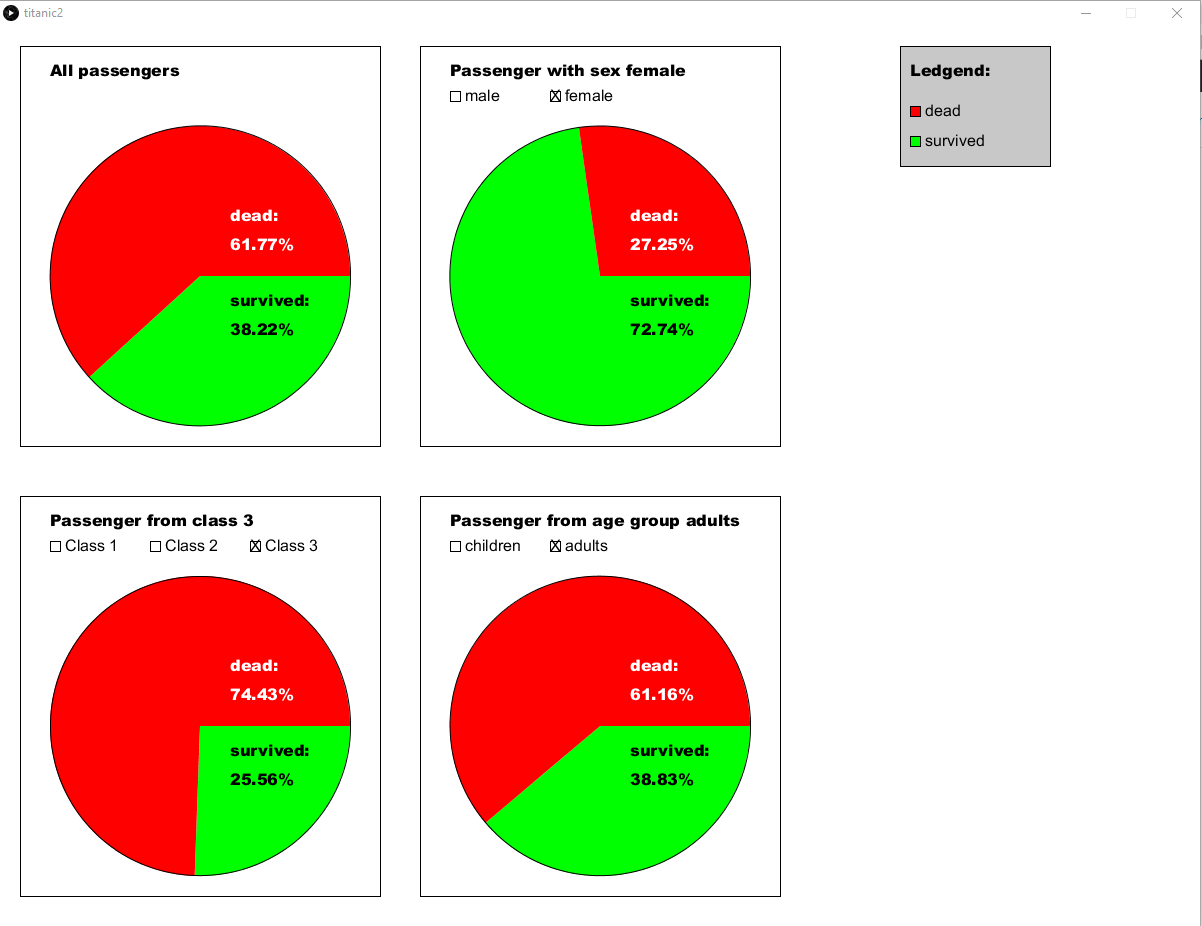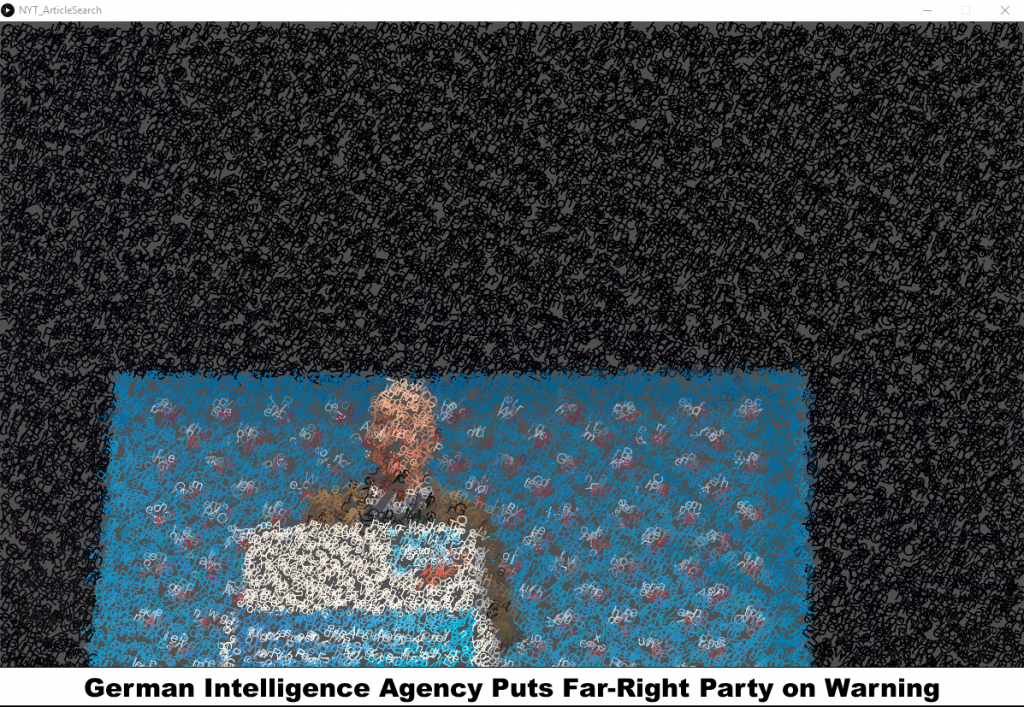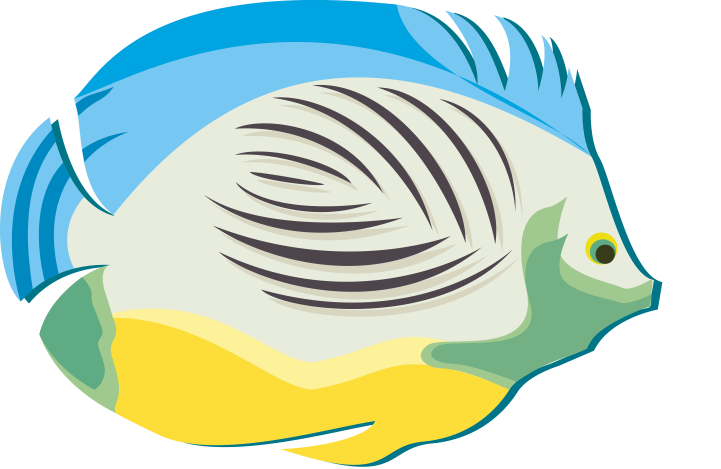R: Titanic
Task:
Show the data about how many people survived and how many people died at the Titanic. Use the data from a given file. This time show how it could look with Shiny in R to present it to the course.
Description of the solution:
I used pie charts to show the percentage of how many people survived and how many died. This infographic is interactive because you can select the passenger’s class, the sex and the age and combine different selections to get a result. Therefore, I divided the program into seven scripts, which can be seen below. Only the ui.R-Script is for the user interface. The other scripts are used for the function.
# ui.R
#Loading libraries
library(shiny)
#Loading other used scripts
# Define UI for application that draws a histogram
shinyUI(fluidPage(
# Application title
titlePanel("Titanic"),
# The inout-fields
sidebarLayout(
sidebarPanel(
radioButtons("pclassIn", "Passenger's class:",
c("All" = "all",
"First class" = "first",
"Secound class" = "secound",
"Third class" = "third")),
selectInput("sexIn", "Passenger's sex:",
c("all" = "all",
"female" = "female",
"male" = "male")),
selectInput("ageIn",
"Passenger's age",
c("All" = "all",
"Children" = "children",
"Adults" = "adults"))
),
# Show a plot of the generated distribution
mainPanel(
plotOutput("pieChart")
)
)
))
#server.R
#Loading libraries
# for Shiny
library(shiny)
#for csv
library(readr)
library(data.table)
#Loading other used scripts
source("scripts/pieChart.R")
source("scripts/passenger.R")
source("scripts/filterPassenger.R")
source("scripts/allPass.R")
source("scripts/getSlices.R")
# Loading Data
titanicData <- read.csv2("data/titanic.csv")
setnames(titanicData, old = "ï..pclass", new = "pclass")
countedPassenger <- filterPassenger(titanicData)
lbls <- c("survived", "not survived")
# Define server logic required to draw a histogram
shinyServer(function(input, output) {
output$pieChart <- renderPlot({
slices <- getSlices(countedPassenger, input)
pieChart(slices, lbls)
})
})
#allPass.R
allPass <- function(actuellPassenger, survivedAll, deadAll){
# Survived or dead
if(actuellPassenger$survived == 1) {
survivedAll <- survivedAll + 1
}
if(actuellPassenger$survived == 0){
deadAll <- deadAll + 1
}
allPassenger <- list("survived" = survivedAll, "dead" = deadAll)
return(allPassenger)
}
# pieChart.R
# Source: https://www.statmethods.net/graphs/pie.html
pieChart <- function(slices , lbls){
pct <- round(slices/sum(slices)*100)
lbls <- paste(lbls, pct) # add percents to labels
lbls <- paste(lbls,"%",sep="") # ad % to labels
colors = c("green" ,"red")
pie(slices,labels = lbls, col=colors,
main="Pie Chart of Titanic")
}
# passenger.R
passenger <- function(titanicData, myRow){
#print(titanicData$pclass[myRow])
pclass <- titanicData$pclass[myRow]
#pclass <- 1
sex <- titanicData$sex[myRow]
age <- titanicData$age[myRow]
survived <- titanicData$survived[myRow]
pass <- list("pclass" = pclass, "sex" = sex, "age" = age, "survived" = survived)
return(pass)
}
# getSlices.R
getSlices <- function(countedPassenger, input){
choiceClass <- input$pclassIn;
choiceSex <- input$sexIn;
choiceAge <- input$ageIn;
sclices <- c(0,0);
lbls <- c();
#all
if(choiceClass == "all" && choiceSex == "all" && choiceAge == "all"){
slices <- c(countedPassenger$allPassenger$survived, countedPassenger$allPassenger$dead)
}
# class
if(choiceClass != "all" && choiceSex == "all" && choiceAge == "all"){
# first class
if(choiceClass == "first"){
slices <- c(countedPassenger$firstClassPassenger$survived, countedPassenger$firstClassPassenger$dead)
}
# secound class
if(choiceClass == "secound"){
slices <- c(countedPassenger$secoundClassPassenger$survived, countedPassenger$secoundClassPassenger$dead)
}
# third class
if(choiceClass == "third"){
slices <- c(countedPassenger$thirdClassPassenger$survived, countedPassenger$thirdClassPassenger$dead)
}
}
# sex
if(choiceClass == "all" && choiceSex != "all" && choiceAge == "all"){
# female
if(choiceSex == "female"){
slices <- c(countedPassenger$femalePassenger$survived, countedPassenger$femalePassenger$dead)
}
# male
if(choiceSex == "male"){
slices <- c(countedPassenger$malePassenger$survived, countedPassenger$malePassenger$dead)
}
}
# age
if(choiceClass == "all" && choiceSex == "all" && choiceAge != "all"){
# children
if(choiceAge == "children"){
slices <- c(countedPassenger$childPassenger$survived, countedPassenger$childPassenger$dead)
}
# adults
if(choiceAge == "adults"){
slices <- c(countedPassenger$adultPassenger$survived, countedPassenger$adultPassenger$dead)
}
}
# class sex
if(choiceClass != "all" && choiceSex != "all" && choiceAge == "all"){
# first class female
if(choiceClass == "first" && choiceSex == "female"){
slices <- c(countedPassenger$firstClassFemalePassenger$survived, countedPassenger$firstClassFemalePassenger$dead)
}
# first class male
if(choiceClass == "first" && choiceSex == "male"){
slices <- c(countedPassenger$firstClassMalePassenger$survived, countedPassenger$firstClassMalePassenger$dead)
}
# secound class female
if(choiceClass == "secound" && choiceSex == "female"){
slices <- c(countedPassenger$secoundClassFemalePassenger$survived, countedPassenger$secoundClassFemalePassenger$dead)
}
# secound class male
if(choiceClass == "secound" && choiceSex == "male"){
slices <- c(countedPassenger$secoundClassMalePassenger$survived, countedPassenger$secoundClassMalePassenger$dead)
}
# third class female
if(choiceClass == "third" && choiceSex == "female"){
slices <- c(countedPassenger$thirdClassFemalePassenger$survived, countedPassenger$thirdClassFemalePassenger$dead)
}
# third class male
if(choiceClass == "third" && choiceSex == "male"){
slices <- c(countedPassenger$thirdClassMalePassenger$survived, countedPassenger$thirdClassMalePassenger$dead)
}
}
# class age
if(choiceClass != "all" && choiceSex == "all" && choiceAge != "all"){
# first class children
if(choiceClass == "first" && choiceAge == "children"){
slices <- c(countedPassenger$firstClassChildPassenger$survived, countedPassenger$firstClassChildPassenger$dead)
}
# first class adults
if(choiceClass == "first" && choiceAge == "adults"){
slices <- c(countedPassenger$firstClassAdultPassenger$survived, countedPassenger$firstClassAdultPassenger$dead)
}
# secound class children
if(choiceClass == "secound" && choiceAge == "children"){
slices <- c(countedPassenger$secoundClassChildPassenger$survived, countedPassenger$secoundClassChildPassenger$dead)
}
# secound class adults
if(choiceClass == "secound" && choiceAge == "adults"){
slices <- c(countedPassenger$secoundClassAdultPassenger$survived, countedPassenger$secoundClassAdultPassenger$dead)
}
# third class children
if(choiceClass == "third" && choiceAge == "children"){
slices <- c(countedPassenger$thirdClassChildPassenger$survived, countedPassenger$thirdClassChildPassenger$dead)
}
# third class adults
if(choiceClass == "third" && choiceAge == "adults"){
slices <- c(countedPassenger$thirdClassAdultPassenger$survived, countedPassenger$thirdClassAdultPassenger$dead)
}
}
# sex age
if(choiceClass == "all" && choiceSex != "all" && choiceAge != "all"){
# female children
if(choiceSex == "female" && choiceAge == "children"){
slices <- c(countedPassenger$femaleChildPassenger$survived, countedPassenger$femaleChildPassenger$dead)
}
# male children
if(choiceSex == "male" && choiceAge == "children"){
slices <- c(countedPassenger$maleChildPassenger$survived, countedPassenger$maleChildPassenger$dead)
}
# female adults
if(choiceSex == "female" && choiceAge == "adults"){
slices <- c(countedPassenger$femaleAdultPassenger$survived, countedPassenger$femaleAdultPassenger$dead)
}
# male adults
if(choiceSex == "male" && choiceAge == "adults"){
slices <- c(countedPassenger$maleAdultPassenger$survived, countedPassenger$maleAdultPassenger$dead)
}
}
# class sex age
if(choiceClass != "all" && choiceSex != "all" && choiceAge != "all"){
# first class female children
if(choiceClass == "first" && choiceSex == "female" && choiceAge == "children"){
slices <- c(countedPassenger$firstClassFemaleChildPassenger$survived, countedPassenger$firstClassFemaleChildPassenger$dead)
}
# first class male children
if(choiceClass == "first" && choiceSex == "male" && choiceAge == "children"){
slices <- c(countedPassenger$firstClassMaleChildPassenger$survived, countedPassenger$firstClassMaleChildPassenger$dead)
}
# first class female adult
if(choiceClass == "first" && choiceSex == "female" && choiceAge == "adults"){
slices <- c(countedPassenger$firstClassFemaleAdultPassenger$survived, countedPassenger$firstClassFemaleAdultPassenger$dead)
}
# first class adult
if(choiceClass == "first" && choiceSex == "male" && choiceAge == "adults"){
slices <- c(countedPassenger$firstClassMaleAdultPassenger$survived, countedPassenger$firstClassMaleAdultPassenger$dead)
}
# secound class female children
if(choiceClass == "secound" && choiceSex == "female" && choiceAge == "children"){
slices <- c(countedPassenger$secoundClassFemaleChildPassenger$survived, countedPassenger$secoundClassFemaleChildPassenger$dead)
}
# secound class male children
if(choiceClass == "secound" && choiceSex == "male" && choiceAge == "children"){
slices <- c(countedPassenger$secoundClassMaleChildPassenger$survived, countedPassenger$secoundClassMaleChildPassenger$dead)
}
# secound class female adult
if(choiceClass == "secound" && choiceSex == "female" && choiceAge == "adults"){
slices <- c(countedPassenger$secoundClassFemaleAdultPassenger$survived, countedPassenger$secoundClassFemaleAdultPassenger$dead)
}
# secound class adult
if(choiceClass == "secound" && choiceSex == "male" && choiceAge == "adults"){
slices <- c(countedPassenger$secoundClassMaleAdultPassenger$survived, countedPassenger$secoundClassMaleAdultPassenger$dead)
}
# third class female children
if(choiceClass == "third" && choiceSex == "female" && choiceAge == "children"){
slices <- c(countedPassenger$thirdClassFemaleChildPassenger$survived, countedPassenger$thirdClassFemaleChildPassenger$dead)
}
# third class male children
if(choiceClass == "third" && choiceSex == "male" && choiceAge == "children"){
slices <- c(countedPassenger$thirdClassMaleChildPassenger$survived, countedPassenger$thirdClassMaleChildPassenger$dead)
}
# third class female adult
if(choiceClass == "third" && choiceSex == "female" && choiceAge == "adults"){
slices <- c(countedPassenger$thirdClassFemaleAdultPassenger$survived, countedPassenger$thirdClassFemaleAdultPassenger$dead)
}
# third class adult
if(choiceClass == "third" && choiceSex == "male" && choiceAge == "adults"){
slices <- c(countedPassenger$thirdClassMaleAdultPassenger$survived, countedPassenger$thirdClassMaleAdultPassenger$dead)
}
}
#print(slices)
return(slices)
}
# filterPassenger.R
filterPassenger <- function(titanicData){
allPassenger <-list("survived" = 0, "dead" = 0);
femalePassenger <-list("survived" = 0, "dead" = 0);
malePassenger <-list("survived" = 0, "dead" = 0);
childPassenger <-list("survived" = 0, "dead" = 0);
adultPassenger <-list("survived" = 0, "dead" = 0);
femaleChildPassenger <-list("survived" = 0, "dead" = 0);
maleChildPassenger <-list("survived" = 0, "dead" = 0);
femaleAdultPassenger <-list("survived" = 0, "dead" = 0);
maleAdultPassenger <-list("survived" = 0, "dead" = 0);
firstClassPassenger <-list("survived" = 0, "dead" = 0);
secoundClassPassenger <-list("survived" = 0, "dead" = 0);
thirdClassPassenger <-list("survived" = 0, "dead" = 0);
firstClassFemalePassenger <-list("survived" = 0, "dead" = 0);
secoundClassFemalePassenger <-list("survived" = 0, "dead" = 0);
thirdClassFemalePassenger <-list("survived" = 0, "dead" = 0);
firstClassMalePassenger <-list("survived" = 0, "dead" = 0);
secoundClassMalePassenger <-list("survived" = 0, "dead" = 0);
thirdClassMalePassenger <-list("survived" = 0, "dead" = 0);
firstClassChildPassenger <-list("survived" = 0, "dead" = 0);
secoundClassChildPassenger <-list("survived" = 0, "dead" = 0);
thirdClassChildPassenger <-list("survived" = 0, "dead" = 0);
firstClassAdultPassenger <-list("survived" = 0, "dead" = 0);
secoundClassAdultPassenger <-list("survived" = 0, "dead" = 0);
thirdClassAdultPassenger <-list("survived" = 0, "dead" = 0);
firstClassFemaleChildPassenger <-list("survived" = 0, "dead" = 0);
secoundClassFemaleChildPassenger <-list("survived" = 0, "dead" = 0);
thirdClassFemaleChildPassenger <-list("survived" = 0, "dead" = 0);
firstClassFemaleAdultPassenger <-list("survived" = 0, "dead" = 0);
secoundClassFemaleAdultPassenger <-list("survived" = 0, "dead" = 0);
thirdClassFemaleAdultPassenger <-list("survived" = 0, "dead" = 0);
firstClassMaleChildPassenger <-list("survived" = 0, "dead" = 0);
secoundClassMaleChildPassenger <-list("survived" = 0, "dead" = 0);
thirdClassMaleChildPassenger <-list("survived" = 0, "dead" = 0);
firstClassMaleAdultPassenger <-list("survived" = 0, "dead" = 0);
secoundClassMaleAdultPassenger <-list("survived" = 0, "dead" = 0);
thirdClassMaleAdultPassenger <-list("survived" = 0, "dead" = 0);
for (myRow in 1:1309){
actuellPassenger <- passenger(titanicData, myRow)
#print(paste0("class: ", actuellPassenger$pclass))
allPassenger <- allPass(actuellPassenger,allPassenger$survived, allPassenger$dead)
#print(paste0("survived: ", allPassenger$survived))
#print(paste0("dead: ", allPassenger$dead))
# Survived or dead first class
if(actuellPassenger$pclass == 1){
firstClassPassenger <- allPass(actuellPassenger, firstClassPassenger$survived, firstClassPassenger$dead)
}
# Survived or dead secound class
if(actuellPassenger$pclass == 2){
secoundClassPassenger <- allPass(actuellPassenger, secoundClassPassenger$survived, secoundClassPassenger$dead)
}
# Survived or dead third class
if(actuellPassenger$pclass == 3){
thirdClassPassenger <- allPass(actuellPassenger, thirdClassPassenger$survived, thirdClassPassenger$dead)
}
if(!is.na(actuellPassenger$sex)){
# Survived or dead female
if(actuellPassenger$sex == "female"){
femalePassenger <- allPass(actuellPassenger, femalePassenger$survived, femalePassenger$dead)
}
# Survived or dead male
if(actuellPassenger$sex == "male"){
malePassenger <- allPass(actuellPassenger, malePassenger$survived, malePassenger$dead)
}
# Survived or dead first class female
if(actuellPassenger$pclass == 1 && actuellPassenger$sex == "female"){
firstClassFemalePassenger <- allPass(actuellPassenger, firstClassFemalePassenger$survived, firstClassFemalePassenger$dead)
}
# Survived or dead secound class female
if(actuellPassenger$pclass == 2 && actuellPassenger$sex == "female"){
secoundClassFemalePassenger <- allPass(actuellPassenger, secoundClassFemalePassenger$survived, secoundClassFemalePassenger$dead)
}
# Survived or dead third class female
if(actuellPassenger$pclass == 3 && actuellPassenger$sex == "female"){
thirdClassFemalePassenger <- allPass(actuellPassenger, thirdClassFemalePassenger$survived, thirdClassFemalePassenger$dead)
}
# Survived or dead first class male
if(actuellPassenger$pclass == 1 && actuellPassenger$sex == "male"){
firstClassMalePassenger <- allPass(actuellPassenger, firstClassMalePassenger$survived, firstClassMalePassenger$dead)
}
# Survived or dead secound class male
if(actuellPassenger$pclass == 2 && actuellPassenger$sex == "male"){
secoundClassMalePassenger <- allPass(actuellPassenger, secoundClassMalePassenger$survived, secoundClassMalePassenger$dead)
}
# Survived or dead third class male
if(actuellPassenger$pclass == 3 && actuellPassenger$sex == "male"){
thirdClassMalePassenger <- allPass(actuellPassenger, thirdClassMalePassenger$survived, thirdClassMalePassenger$dead)
}
}
if(!is.na(actuellPassenger$age)){
#print(actuellPassenger$age)
# Survived or dead child
if(actuellPassenger$age <= 18){
childPassenger <- allPass(actuellPassenger, childPassenger$survived, childPassenger$dead)
}
# Survived or dead adult
if(actuellPassenger$age >= 18){
adultPassenger <- allPass(actuellPassenger, adultPassenger$survived, adultPassenger$dead)
}
# Survived or dead first class child
if(actuellPassenger$pclass == 1 && actuellPassenger$age <= 18){
firstClassChildPassenger <- allPass(actuellPassenger, firstClassChildPassenger$survived, firstClassChildPassenger$dead)
}
# Survived or dead secound class child
if(actuellPassenger$pclass == 2 && actuellPassenger$age <= 18){
secoundClassChildPassenger <- allPass(actuellPassenger, secoundClassChildPassenger$survived, secoundClassChildPassenger$dead)
}
# Survived or dead third class child
if(actuellPassenger$pclass == 3 && actuellPassenger$age <= 18){
thirdClassChildPassenger <- allPass(actuellPassenger, thirdClassChildPassenger$survived, thirdClassChildPassenger$dead)
}
# Survived or dead first class adult
if(actuellPassenger$pclass == 1 && actuellPassenger$age >= 18){
firstClassAdultPassenger <- allPass(actuellPassenger, firstClassAdultPassenger$survived, firstClassAdultPassenger$dead)
}
# Survived or dead secound class adult
if(actuellPassenger$pclass == 2 && actuellPassenger$age >= 18){
secoundClassAdultPassenger <- allPass(actuellPassenger, secoundClassAdultPassenger$survived, secoundClassAdultPassenger$dead)
}
# Survived or dead third class adult
if(actuellPassenger$pclass == 3 && actuellPassenger$age >= 18){
thirdClassAdultPassenger <- allPass(actuellPassenger, thirdClassAdultPassenger$survived, thirdClassAdultPassenger$dead)
}
}
if(!is.na(actuellPassenger$age) && !is.na(actuellPassenger$sex)){
# Survived or dead female child
if(actuellPassenger$age <= 18 && actuellPassenger$sex == "female"){
femaleChildPassenger <- allPass(actuellPassenger, femaleChildPassenger$survived, femaleChildPassenger$dead)
}
# Survived or dead female adult
if(actuellPassenger$age >= 18 && actuellPassenger$sex == "female"){
femaleAdultPassenger <- allPass(actuellPassenger, femaleAdultPassenger$survived, femaleAdultPassenger$dead)
}
# Survived or dead male child
if(actuellPassenger$age <= 18 && actuellPassenger$sex == "male"){
maleChildPassenger <- allPass(actuellPassenger, maleChildPassenger$survived, maleChildPassenger$dead)
}
# Survived or dead male adult
if(actuellPassenger$age >= 18 && actuellPassenger$sex == "male"){
maleAdultPassenger <- allPass(actuellPassenger, maleAdultPassenger$survived, maleAdultPassenger$dead)
}
# Survived or dead first class female child
if(actuellPassenger$pclass == 1 && actuellPassenger$sex == "female" && actuellPassenger$age <= 18){
firstClassFemaleChildPassenger <- allPass(actuellPassenger, firstClassFemaleChildPassenger$survived, firstClassFemaleChildPassenger$dead)
}
# Survived or dead secound class female child
if(actuellPassenger$pclass == 2 && actuellPassenger$sex == "female" && actuellPassenger$age <= 18){
secoundClassFemaleChildPassenger <- allPass(actuellPassenger, secoundClassFemaleChildPassenger$survived, secoundClassFemaleChildPassenger$dead)
}
# Survived or dead third class female child
if(actuellPassenger$pclass == 3 && actuellPassenger$sex == "female" && actuellPassenger$age <= 18){
thirdClassFemaleChildPassenger <- allPass(actuellPassenger, thirdClassFemaleChildPassenger$survived, thirdClassFemaleChildPassenger$dead)
}
# Survived or dead first class female adult
if(actuellPassenger$pclass == 1 && actuellPassenger$sex == "female" && actuellPassenger$age >= 18){
firstClassFemaleAdultPassenger <- allPass(actuellPassenger, firstClassFemaleAdultPassenger$survived, firstClassFemaleAdultPassenger$dead)
}
# Survived or dead secound class female adult
if(actuellPassenger$pclass == 2 && actuellPassenger$sex == "female" && actuellPassenger$age >= 18){
secoundClassFemaleAdultPassenger <- allPass(actuellPassenger, secoundClassFemaleAdultPassenger$survived, secoundClassFemaleAdultPassenger$dead)
}
# Survived or dead third class female adult
if(actuellPassenger$pclass == 3 && actuellPassenger$sex == "female" && actuellPassenger$age >= 18){
thirdClassFemaleAdultPassenger <- allPass(actuellPassenger, thirdClassFemaleAdultPassenger$survived, thirdClassFemaleAdultPassenger$dead)
}
# Survived or dead first class male child
if(actuellPassenger$pclass == 1 && actuellPassenger$sex == "male" && actuellPassenger$age <= 18){
firstClassMaleChildPassenger <- allPass(actuellPassenger, firstClassMaleChildPassenger$survived, firstClassMaleChildPassenger$dead)
}
# Survived or dead secound class male child
if(actuellPassenger$pclass == 2 && actuellPassenger$sex == "male" && actuellPassenger$age <= 18){
secoundClassMaleChildPassenger <- allPass(actuellPassenger, secoundClassMaleChildPassenger$survived, secoundClassMaleChildPassenger$dead)
}
# Survived or dead third class male child
if(actuellPassenger$pclass == 3 && actuellPassenger$sex == "male" && actuellPassenger$age <= 18){
thirdClassMaleChildPassenger <- allPass(actuellPassenger, thirdClassMaleChildPassenger$survived, thirdClassMaleChildPassenger$dead)
}
# Survived or dead first class male adult
if(actuellPassenger$pclass == 1 && actuellPassenger$sex == "male" && actuellPassenger$age >= 18){
firstClassMaleAdultPassenger <- allPass(actuellPassenger, firstClassMaleAdultPassenger$survived, firstClassMaleAdultPassenger$dead)
}
# Survived or dead secound class female adult
if(actuellPassenger$pclass == 2 && actuellPassenger$sex == "female" && actuellPassenger$age >= 18){
secoundClassMaleAdultPassenger <- allPass(actuellPassenger, secoundClassMaleAdultPassenger$survived, secoundClassMaleAdultPassenger$dead)
}
# Survived or dead third class female adult
if(actuellPassenger$pclass == 3 && actuellPassenger$sex == "female" && actuellPassenger$age >= 18){
thirdClassMaleAdultPassenger <- allPass(actuellPassenger, thirdClassMaleAdultPassenger$survived, thirdClassMaleAdultPassenger$dead)
}
}
}
return(list("allPassenger" = allPassenger,
"femalePassenger" = femalePassenger,
"malePassenger" = malePassenger,
"childPassenger" = childPassenger,
"adultPassenger" = adultPassenger,
"femaleChildPassenger" = femaleChildPassenger,
"maleChildPassenger" = maleChildPassenger,
"femaleAdultPassenger" = femaleAdultPassenger,
"maleAdultPassenger" = maleAdultPassenger,
"firstClassPassenger" = firstClassPassenger,
"secoundClassPassenger" = secoundClassPassenger,
"thirdClassPassenger" = thirdClassPassenger,
"firstClassFemalePassenger" = firstClassFemalePassenger,
"secoundClassFemalePassenger" = secoundClassFemalePassenger,
"thirdClassFemalePassenger" = thirdClassFemalePassenger,
"firstClassMalePassenger" = firstClassMalePassenger,
"secoundClassMalePassenger" = secoundClassMalePassenger,
"thirdClassMalePassenger" = thirdClassMalePassenger,
"firstClassChildPassenger" = firstClassChildPassenger,
"secoundClassChildPassenger" = secoundClassChildPassenger,
"thirdClassChildPassenger" = thirdClassChildPassenger,
"firstClassAdultPassenger" = firstClassAdultPassenger,
"secoundClassAdultPassenger" = secoundClassAdultPassenger,
"thirdClassAdultPassenger" = thirdClassAdultPassenger,
"firstClassFemaleChildPassenger" = firstClassFemaleChildPassenger,
"secoundClassFemaleChildPassenger" = secoundClassFemaleChildPassenger,
"thirdClassFemaleChildPassenger" = thirdClassFemaleChildPassenger,
"firstClassFemaleAdultPassenger" = firstClassFemaleAdultPassenger,
"secoundClassFemaleAdultPassenger" = secoundClassFemaleAdultPassenger,
"thirdClassFemaleAdultPassenger" = thirdClassFemaleAdultPassenger,
"firstClassMaleChildPassenger" = firstClassMaleChildPassenger,
"secoundClassMaleChildPassenger" = secoundClassMaleChildPassenger,
"thirdClassMaleChildPassenger" = thirdClassMaleChildPassenger,
"firstClassMaleAdultPassenger" = firstClassMaleAdultPassenger,
"secoundClassMaleAdultPassenger" = secoundClassMaleAdultPassenger,
"thirdClassMaleAdultPassenger" = thirdClassMaleAdultPassenger))
}

